#jason gulley
Photo

A ribbon of eelgrass in the mouth of a manatee
PHOTOGRAPH BY JASON GULLEY

1K notes
·
View notes
Text
Glacier Caves Rule!
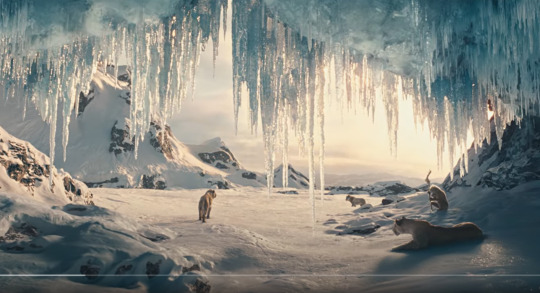
Welp, the Mufasa trailer has come out, while I'm still absolutely terrified of commenting more (because OH boy, I STILL remember the sheer unadultrerated vitriol regarding the 2019 Lion King movie, a movie that I very much liked, big flaws and all, but SO many of my animation peers Haaaaated and thus I felt like a traitor)... I couldn't help but LOVE this shot.
It appeals to the paleoartist in me, as it's something I totally can see be substituted with Cave Lions during the pleistocene! Mountainous glacier caves are awesome!

(Photo by Jason Gulley for National Geographic)
Heck, Rafiki could be replaced with a Barbary Macaque or a Gelada and it would be a PERFECT substitute for a fantasy story featuring pleistocene Ice Age fauna.
Lots of paleoart ideas here!
58 notes
·
View notes
Text

Florida manatees
Photographed by Jason Gulley
National Geographic, Best Wildlife Photos of 2023
76 notes
·
View notes
Text

A mother manatee and her calf in Florida’s Crystal River amid eelgrass, which is crucial for supporting the large mammals. Jason Gulley / Wildlife Photographer of the Year / Smithsonian Magazine #manatee #florida
7 notes
·
View notes
Text
Witches on the strand collecting ritual rudiment
Acrid smoke the witch’s alembic bubbling opal
High prizing simulacrum, correlate with a victim
On the beach before dawn in wintertime
Hauling logs seaweed-spined several miles
To the furthest skull-strewn span of deeded land.
.
Visiting stars insistent, dead the hands who lit them
Liminal vignette’s trippy nipple coloured sky, tides fried cerulean
By insistent centrifugal motion of hidden limbs
Treasures of ocean, commotion lasting until sun’s outguttering,
Smuggled to unhidden hideouts, to be seen by witch eyes
Shell fragments and wigs of lank seaweed, plied unto violent ends.
.
In practice, an act is committed
With a specific unspoken intention in mind
No eye that vantage hights
Hidden greasing formless hands unto advantage
Fomenting favour, luck through the sanguinary.
.
Hands wrinkled, like aborted verse balled
Standing taller in mind than eye by glamour’s guile
Around her manse ninemilesround, smoke-surreal mires
Gulley razor-rocked, at which dim Jason, womanloved, baulked.
.
A hairlock, one tonsured sprig
Sheep dipped in hemlock
She wears as vestment a Hebrew vest of wood hewn
Its face grid of facets, in which gems languish; lapis,
Agate, ruby, emerald, bronze sacred to Taurian Apis
In hue divers that it appeared she who the Law foreswore
Wore like a fool to Goneril’s storm-maddened father a motley suit.
5 notes
·
View notes
Text
These photos are among several highly commended in this year's Wildlife Photographer of the Year awards.

The competition's winning photographs will be announced on 8 October, followed by an exhibition at the Natural History Museum, showcasing 100 photographs.
Dr Jason Gulley took one of the pictures. He said: "I went in to get a few pictures for a project on environmental impacts and conservation, but I got obsessed."






📸1 Jason Gulley
📸2 Jose Manuel Grandío
📸3 Samual Stone
📸4 lan Ford
📸5 Lam Soon Tak
📸6 Georgina Steytler
📸7 William Fortescue
#wildlifephotography #AlltheNews
0 notes
Text
Dietro le quinte del salvataggio di un lamantino
Il salvataggio dei giovani lamantini Quando una carenza di alghe ha causato una moria di massa di lamantini, gli scienziati si sono attivati per salvare i piccoli orfani. In seguito a tre anni di cure allo zoo, i lamantini sono pronti a tornare in libertà. La cura e il recupero al ZooTampa Il fotografo Jason Gulley racconta come ZooTampa si occupi del salvataggio, del recupero e della cura dei lamantini orfani. Grazie alle attenzioni ricevute, questi animali sono cresciuti sani e forti pronti per tornare nella loro habitat naturale. Il ritorno alla libertà Dopo anni di cure e attenzioni, i
0 notes
Text

Mahesh Magar, a guide with Himalayan Research Expeditions, exits a cave on the Khumbu Glacier, just a short walk from Everest Base Camp. With elevations of more than 17,500 feet above sea level, these are some of the highest mapped caves in the world. Caves like this one are forming in high altitude Himalayan glaciers as soaring temperatures send more meltwater cascading through the insides of glaciers, melting tunnels that are literally rotting glaciers from the inside out.
These Caves Mean Death For Himalayan Glaciers
Otherworldly Ice Caves are Rotting the Glaciers From the Inside Out, Putting Villages Below in the Path of Devastating Potential Flash Floods.
— By Douglas Fox | Photographs By Jason Gulley | January 10, 2024
Jason Gulley has spent 19 years crawling through the insides of glaciers, from Alaska to Nepal. Sometimes these caves, carved through the ice by running water, are large enough for a truck to drive through. Other times, they’re so narrow that he slides along the slippery floor on his belly. If he pauses, his clothing can freeze to the ice.
Gulley is a geologist at the University of South Florida, who began his career studying limestone caverns. It was only by chance that he started exploring the insides of glaciers. The first time he entered one of these caves in the Mount Everest Region, on Lhotse Glacier, was a harrowing experience.
He and his companion stood outside the entrance, watching basketball-sized rocks rain down from the unstable ice cliff overhead. After gathering his wits, he sprinted inside—followed a moment later by Douglas Benn, a veteran Himalayan Glaciologist from the University of St. Andrews in Scotland.
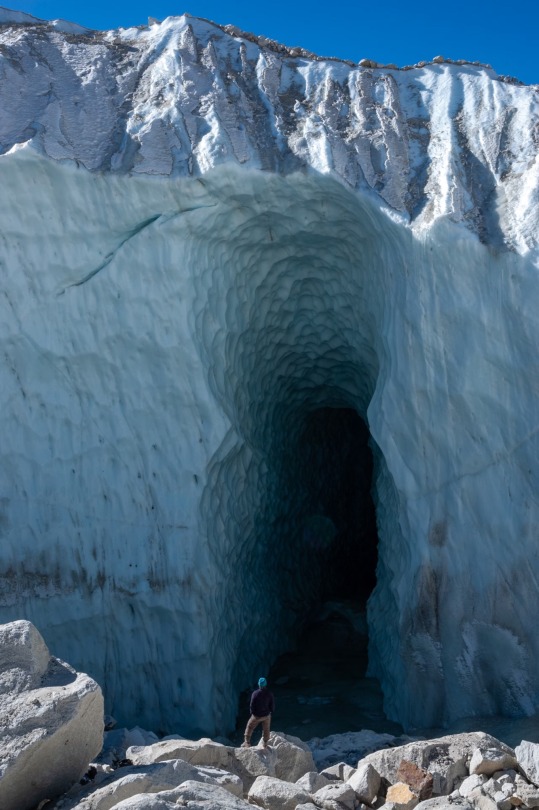
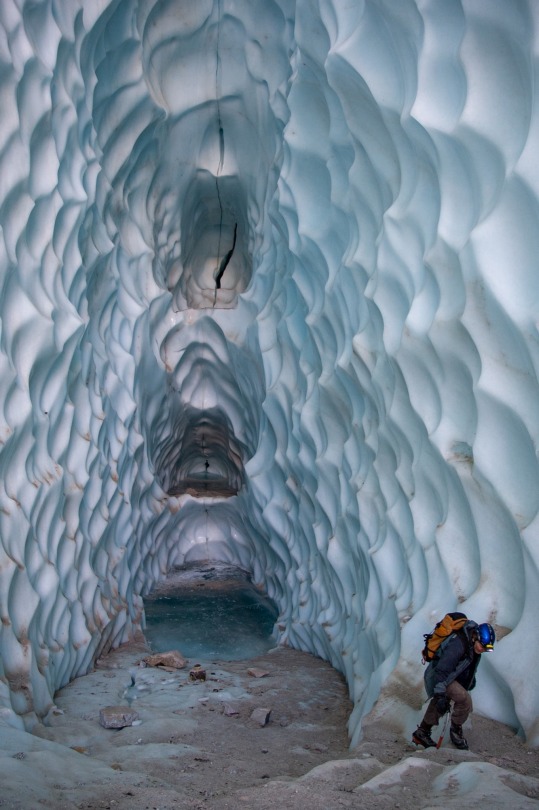
Left: Glaciologist Doug Benn enters a massive cave on the Khumbu Glacier in December 2006. This cave formed as ponds of melted water, sitting on top of glaciers, elevated water pressured and punched open the cracks, causing lake water to surge into the surrounding ice. Right: As the mountainous region warms, these ponds of melted water are becoming more common, hastening the demise of frozen glaciers.
After a few minutes in the cave, they accidentally triggered a minor collapse. The brittle ceiling shattered in a rain of ice shards. “That’s when it really started to dawn on us,” says Gulley. “We really have no idea of what could kill us in here.”
In the years since, Gulley, Benn, and several other scientists have managed to explore these little-known caves. Their work has laid bare the private lives of glaciers—and the disease that is rapidly consuming them.
Glaciers in the Himalaya are thinning by up to nine feet per year, and these caves are playing a pivotal role, hollowing out and collapsing the ice from within.
“It’s the cancer that’s eating what’s left of the glacier,” says Gulley.
As the world warms, the tongues of these glaciers are melting into large lakes, which threaten to unleash flash floods upon villages in the valleys below.
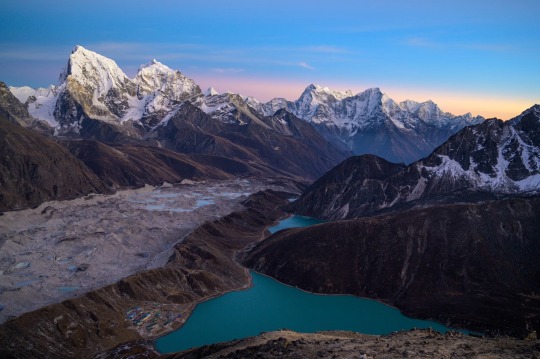
The Sherpa settlement of Gokyo lies beneath the rapidly disappearing Ngozumpa Glacier. Like nearly half of the glaciers in Nepal's Everest Region, the Ngozumpa Glacier is covered in rocky debris shed by adjacent mountains.
Little-explored Caves
Glaciers in the Himalaya differ from what most people imagine. Stand at the lower end of Ngozumpa Glacier, which flows from 26,864-foot Cho Oyu, the world’s sixth-highest mountain, and you will see what appears to be a jumble of rocks filling the valley.
Ngozumpa, like many Himalayan glaciers, is fed by avalanches that sweep down from above—depositing snow, rocks, and boulders onto its upper reaches.
As the glacier descends into warmer air, its surface starts to melt. This removes the upper layers of ice, bringing the buried rubble back to surface. There it accumulates in a layer, up to four feet thick, covering the glacier.
Many Himalayan glaciers are “debris-covered,” like Ngozumpa, and scientists believed that this would insulate them from warming temperatures. But it hasn’t worked out that way, says Teiji Watanabe, a geomorphologist at Hokkaido University in Japan, who has frequently visited the Everest Region since the late 1980s.
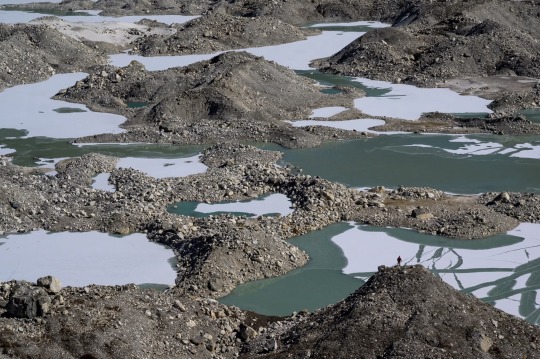
Melting water forms pools on the debris-covered Ngozumpa Glacier, in the Everest region of Nepal. Lakes like these heat up during summer and provide large sources of relatively warm water that can carve cave passages into the ice by melting the layers of ice below.
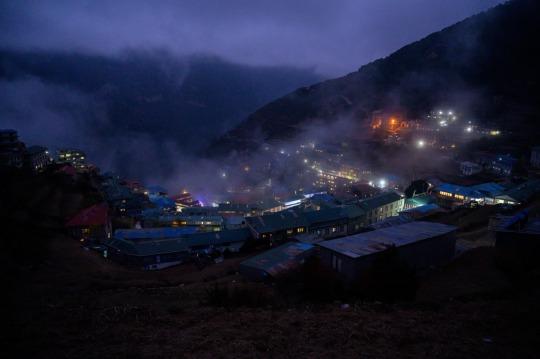
Electric lights in the Sherpa capitol of Namche Bazaar light up the night sky. Namche Bazaar and other nearby Sherpa settlements receive electricity from a small hydroelectric power plant. Infrastructure like this is vulnerable to floods from overlowing glacier lakes.
In the past few decades, the surface of Ngozumpa and other debris-covered glaciers has become pocked with thousands of sinkholes up to 100 feet deep, as the ice shrinks beneath the rocks. Melt ponds frequently fill these depressions. The total area of these ponds has tripled in 30 years—a rate of change that “is really, really amazing,” says Watanabe.
The cause of that rapid change was a mystery. But around the year 2000 Benn, the Scottish glaciologist, noticed a clue.
Melt ponds on Ngozumpa and other debris-covered glaciers often disappeared overnight. At the bottom of these empty depressions, Benn found cave openings, through which the lake had drained.
No one knew how extensive those caves were, or where they went.
But in 2004, Benn met Gulley—an accomplished caver—through a mutual friend.
Benn’s photos of gaping cave openings and pitted glaciers reminded Gulley of limestone landscapes in the Caribbean, where thousands of sinkholes had formed as caves collapsed beneath the surface. With Gulley’s expertise, they entered their first glacier cave in the Everest Region, in 2005.
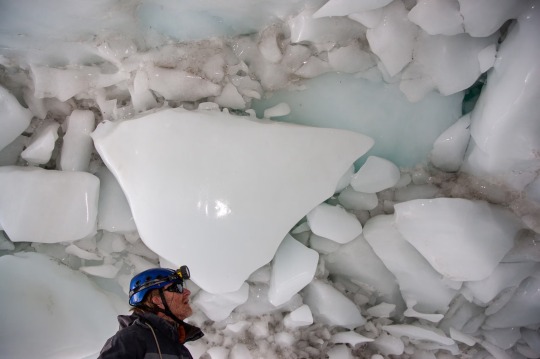
Glaciologist Doug Benn examines the roof of a glacier cave on Nepal's Khumbu Glacier. The entire cave roof consists of blocks of shattered ice that had been frozen together.
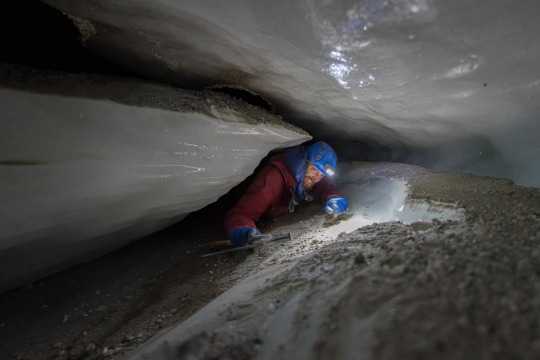
Glacier researcher Matt Covington moves through a tight section of a cave inside the Ngozumpa Glacier, during a 2018 expedition. Crawling at altitudes between 15,000 and 18,000 feet above sea level is one of the most physically demanding parts of cave exploration.
A Downward Spiral of Melting Caves
As they ventured into the darkness, the beams from their headlamps illuminated the fog of their breath. Thin layers of dust, as fine as flour, coated the surfaces — “as if the cave was a store that went out of business 30 years ago,” says Gulley.
They hurried out of that first cave after part of its ceiling collapsed.
Their second cave entry, several days later, didn’t go much better. As they walked down a passage, their spiked crampons crackling on the ice, Gulley suddenly plunged through the floor.
Only later did they realize they’d been walking on a false floor—a veneer of ice, three quarters of an inch thick, that had formed on top of standing water. That water later drained out from below—leaving the five-foot void that Gulley fell into.
They gradually learned to avoid these hazards. And as they explored Ngozumpa Glacier, year after year, Gulley was amazed at how these meandering ice caves resembled limestone caverns—except in the glacier, the ornate scallops, grooves, stalagmites, and stalactites had formed in a few months, rather than thousands of years.
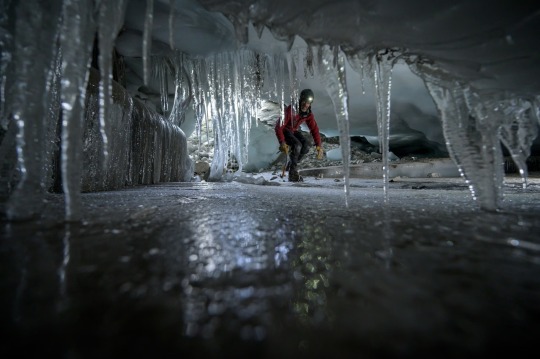
Jason Gulley navigates a cave in Nepal's Ngozumpa Glacier, stooping as he walks. Even experienced cave explorers struggle to descend caves covered in ice.
The caves formed where bands of debris-rich ice provided a weak spot that melt water exploited. The passages were often round, with a deep chasm cutting into the floor, indicating it was carved by gushing water that eventually slowed to a stream.
But glacier caves also differed in some striking ways.
As Gulley and Benn made repeated trips to Ngozumpa Glacier, they saw that narrow passages often squeezed shut from one year to the next—the glacial ice oozing inward like silly putty. Those passages melted open again the next time water from a draining lake gushed through.
These observations led Benn and Gulley to a theory—published in 2017—of how caves erode debris-covered glaciers.
“As those caves expand and collapse, they’re creating new depressions, that create new lakes, that create new caves,” says Gulley.
As this downward spiral continues, the depressions expand and deepen, forming ice cliffs that melt quickly because they’re warmed by sunlight. Warm melt ponds undercut the ice cliffs—crumbling them—exposing more bare ice.
In this way, a depression “can grow faster and faster the bigger it gets,” says Ryan Strickland, a PhD student studying caves at the University of Arkansas.
Strickland used a drone to measure 3,000 depressions on Ngozumpa Glacier. His analysis, published in August, suggests that depressions really do grow more quickly as they expand—consistent with Gulley’s theory that melt caves drive the process.
“It’s absolutely plausible,” says Owen King, a mountain glaciologist at Newcastle University in the United Kingdom, who has worked in this region. “The mechanisms that Ryan has described, we can definitely see evidence for.”
The melt water gushing through caves gathers in a massive lake near the glacier’s terminus. Spillway Lake is half a mile long. It is dammed by a massive ridge of rubble that the glacier piled up over thousands of years. As it grows, it could rupture that dam, sending several million cubic yards of water plunging down the valley.
In 1985, a glacial lake outburst flood eight miles southwest of Ngozumpa swept away 14 bridges, 30 houses, and a hydroelectric plant. This flood risk will increase as more glaciers give way to lakes.

Mere steps from Everest Base Camp, a pair of researchers drop into a glacier cave on Nepal's Khumbu glacier. Rising temperatures and melting ice lowered the ice surface at Everest Base Camp by a staggering 98 feet between 1984 and 2015.
A Remnant Cave Left High and Dry
When Gulley visited Ngozumpa Glacier in 2018 and 2019, he was shocked by what he saw. Very few caves remained. So much of the glacier had sagged down to the level of Spillway Lake, that melt water was no longer driven to flow downhill and create new caves.
They did find one fragment of a cave that Gulley first mapped in 2005. Back then its entrance was at the bottom of a depression. But now all that remained was a short section of cave piercing a ridge of ice.
Even as melt caves disappear from the lower reaches of Ngozumpa, they will penetrate higher up the glacier’s 22-mile length. Melt caves will eviscerate more and more glaciers—creating lakes that could release devastating floods.
“These caves are symptoms of dying glaciers,” says Gulley. “This is what almost all of the glaciers in the Everest Region are going to be turning into.”
1 note
·
View note
Text
Antonio Velardo shares: Una medida desesperada para salvar los corales: sacarlos del océano by Catrin Einhorn and Jason Gulley
By Catrin Einhorn and Jason Gulley
En Florida, equipos dedicados a la restauración de los océanos están trasladando urgentemente muestras a tanques en tierra, mientras una ola de calor marina devasta arrecifes enteros.
Published: August 5, 2023 at 05:01AM
from NYT En español https://ift.tt/5b8DwXx
via IFTTT

View On WordPress
0 notes
Text
So my boyfriend and I have been living in this super shitty apartment building for over a year (I’ve been here a year, he’s been here 3 years, and recently our friend just moved in a few months ago). Nothing works, pipes and showers aren’t sealed so they leak constantly and make the house reek of mildew, the only tub refuses to drain so instead we just have a “bowl of human stew” sitting in the bathroom until we put our own money into fixing everything because the maintenance men have no clue what they are doing and the land lord refuses to provide anything beyond a roof over everyone’s heads.
Well today we finally got approved for a mortgage loan and plan on being out of here in 6 months. If anyone can spare even a few dollars to help with the down payment it would be a tremendous help!
6 notes
·
View notes
Link

By BY JASON GULLEY from NYT Travel https://ift.tt/3AbkFHh
0 notes
Text
Antonio Velardo shares: A Desperate Push to Save Florida’s Coral: Get It Out of the Sea by Catrin Einhorn and Jason Gulley
By Catrin Einhorn and Jason Gulley
Teams dedicated to ocean restoration are urgently moving samples to tanks on land as a marine heat wave devastates entire reefs.
Published: July 31, 2023 at 12:34PM
from NYT Climate https://ift.tt/HvGW2Rx
via IFTTT

View On WordPress
0 notes
Photo

"Unraveling the Mysteries Hidden in Vast Glacier Caves" by BY JASON GULLEY via NYT Travel https://ift.tt/3AbkFHh
0 notes



